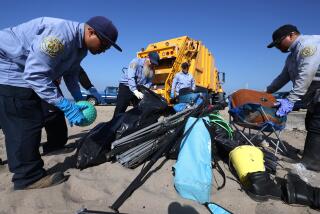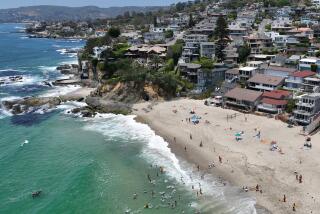Volunteers Gather Data on Trash While Cleaning Up State Beaches
Holding half of a broken Pepsi bottle high above his head, Bobby Duffy, 12, smiled from one side of his cherubic face to the other. “He’s got it,” exulted another boy.
Some of the muddy water ran down the Arcadia boy’s arm, but it mattered little as he tossed the bottle into a trash bag and dived back into the tepid water of Ballona Lagoon near the entrance to Marina del Rey.
Similar attempts were made not just to collect trash but to catalogue it at Malibu, Topanga, Hermosa and 100 beaches in California on Saturday and along the coasts of 23 other states over the last three weeks.
In California, the Coastal Commission sponsored the fourth annual Adopt-a-Beach program as a part of the nationwide effort to determine the amount of garbage strewn along the nation’s coast. Coastal litter became an even greater concern this summer after beaches in the Northeast were closed when medical wastes, including bloody syringes, washed ashore.
Most of the trash here comes from beach-goers. Last year 5,000 volunteers collected 190,000 pounds of litter on California beaches, according to commission spokesman Jack Liebster. On Saturday, 500 volunteers in Ventura County collected 16,000 pounds of trash and 700 people in San Diego picked up 15,000 pounds, he said. They were still tabulating the Los Angeles junk.
This is the first effort, Liebster said, to develop a national picture of beach litter. The information will be used to target the filthiest beaches in the state and encourage schools to adopt a stretch of coast and keep it clean. At the national level, the data will be used to determine the efficacy of an international treaty starting Dec. 31 that bans the dumping of trash from ships at seas.
About 60 people, mostly schoolchildren, seemed to enjoy participating in the cleanup at Marina del Rey. While most volunteers combed the banks of the lagoon, picking up everything from diapers to beer cans, several more adventurous youths dived for the dubious treasures of water-logged underwear and muddy spark plugs.
Gordon Smith kicked and fluttered among schools of small fish and the occasional sting ray in the lagoon’s clear green water. The 12-year-old’s watch read the water temperature at 67.3. “But I think it’s colder,” he said.
The biggest haul of the day required a group effort. Smith and several friends groaned and grimaced as they carried a twisted and rusted car bumper up the bank and across the Lighthouse Bridge to the pickup area. For their labor, their hands and clothes were blackened.
“I’m probably going to have to throw away these shoes,” said one thoroughly begrimed boy.
After spending several hours filling about 50 plastic trash bags, the volunteers sorted the loot. The more squeamish wore plastic gloves. Marking the data cards used at thousands of locations throughout the country, they ticked off plastic, glass, rubber, metal, paper, wood, cloth and Styrofoam, not to mention numerous subdivisions and variants.
Small muck-covered hands thrust dirty rags and bottomless cups into the bags. The young voices blended in a cacophony of “Styrofoam here” and “metal, metal, metal.”
Michael Sedgwick, a science teacher at Pasadena Polytechnic School, said trash is more than an eyesore since it devastates the ecosystem.
Plastic bags, for instance, resemble jelly fish to birds and sea turtles. “They eat them, and it kills them,” he said.
More to Read
Sign up for Essential California
The most important California stories and recommendations in your inbox every morning.
You may occasionally receive promotional content from the Los Angeles Times.










